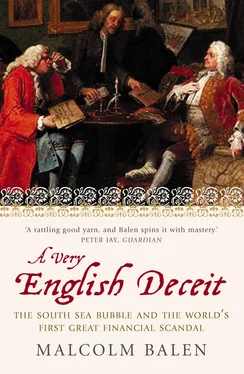In 1715, to cement its place in the Hanoverian order, the Company had declined the interest payments which were due from the government for servicing the national debt. This had saved the Treasury more than £1 million, and in return the Company was allowed to increase its capital size by the same amount, so that it now had several thousand shareholders, more than either the Bank of England or the East India Company. In the same year, for the first time, its share price reached par, the value at which the stock had been launched under Harley. Four years later, in 1719, the Company was also allowed, through an Act of Parliament, to convert a further part of the government’s debt into shares. Unlike Harley, who had merely converted the floating debt (the debt that could be paid off if the Treasury could afford it), the government proposed to sell off that part of the debt to which it was committed for years ahead: this was called the funded, or ‘irredeemable’, debt. By transferring its subscribers to a stock-market holding in the Company, this new small-scale conversion scheme aimed to remove the burden on the Treasury created by the lottery of 1710. Two-thirds of the annuitants eventually took up the offer, and under the terms of the deal the Company agreed to lend the government more than half a million pounds. As a reward, the Company was allowed to sell extra stock for itself, on a rising market, to increase its reserves of cash.
By 1719, therefore, the Company’s capital size had risen past the £12 million mark – and this was financially absurd. In the previous two years, forty-five ships had carried a total of thirteen thousand slaves for the Company under the slaving contract, but it had still not made a profit. Nor had it made any money on its direct trade with South America. Yet, paradoxically, the financial health of the Company, as the dispenser of half the entire joint-stock capital in the country, was vital to the economic security of the nation. And it readily embraced this nonsensical reality: its desire to develop the Sword Blade Bank, from which it had emerged, grew stronger than its attempts to sell its goods abroad. Robert Knight, the general manager of the bank, was appointed as the Company’s cashier and became the main conduit between the two sides of the operation, his advancement a tangible sign that the Company was more eager to pursue its role as the holder of the national debt than as a trading concern.
Even as its trading base shrank to nothing overseas, the Company’s political horizons grew wider. Its domestic ambitions were reflected in its plan to move into a magnificent flat-fronted building on the north-east corner of Threadneedle Street. More than thirty windows, on three levels, enabled the directors in South Sea House to look down on to the financial district at its feet; there was a dark basement below the iron railings at the front, while a colonnaded entrance made a grand statement of its claim to be an accepted part of the establishment. Appropriately, its rival, the Bank of England, stood at the other end of the street.
To the Bank’s chagrin, the connection between the Company and the government was close, and becoming closer. John Aislabie, as Chancellor of the Exchequer, appointed Francis Hawes, one of the Company directors, to be Receiver-General of Customs; four directors were also MPs, and another six had posts that had connections with the public purse. These men provided a key link between the Company and the institutions which controlled public money. The South Sea Company had become a fully fledged member of Britain’s political, financial and social order, and, in recognition, the Company’s newly launched ship was called The Royal Prince. The Prince himself, and his courtiers, were treated to a lavish party on board, to celebrate the ship’s impending departure for the South Seas in search of the bottomless riches on which the Company’s foundation was supposedly predicated.
It should have been a big moment in the Company’s history. But the royal establishment which Blunt was courting was far from united. The King’s frequent absences in Hanover had made him ever more intolerant of his son, suspicious as he was that the Prince had been manoeuvring against him, and resentful of having to return to the foreign land he had inherited against his better judgement. All the signals pointed towards there being a familial explosion, and, given the curious nature of George’s family history, it duly came in the happiest of circumstances.
In November 1717, the Prince’s beautiful wife Caroline of Anspach had given birth to a baby boy, her fifth child. Instead of celebrating, however, the King and his son fell out in spectacular fashion. It was, strictly speaking, the King’s right as ruler to name the boy’s godparents; but the Prince wished to do so himself, and chose the Queen of Prussia and the Duke of York. The ensuing fall-out was dramatic. The King banished the Prince and his wife from the palace without their children. A few weeks later, the baby boy died. The Hanover family seemed genetically programmed for disaster.
The political impact of the schism was immediate: George had, through his intemperate actions, forced his son into internal exile. A rival court was established, with the Prince choosing Leicester House at St Martin’s in London as his base, barely a mile from St James’s Palace. No longer was the King in total command of all he surveyed. This time, dissent had a focus, a rival power base in which the thwarted ambitions of the powerless and the embittered could find expression. The political tensions were reflected most obviously in the South Sea Company’s make-up, with the rivalry between the King and his son reflected in the efforts made by their respective candidates, in 1718, to be elected to the Court of Directors. Walpole and Townshend’s candidates stood against the government, and by implication the King, with some success. Harley’s brother Edward wrote: ‘the King’s people … have lost it for sub- and deputy-governors of the South Sea, and those who are reckoned of the Prince’s party have carried it’.
Crucially, the row between the King and his son led directly to George I, as an act of revenge, assuming the role of Governor of the South Sea Company. It was the highest accolade the ambitious directors could have sought for their upstart venture, but it was dangerous territory for the monarchy. It signified not just royal approval of the enterprise, but royal entanglement too. By his presence at the head of the company, the King had signalled that the business was to be trusted. But the obverse might be proved, too. If for any reason the Company failed, where did this leave a monarch unloved by his people, assailed by Jacobite incursions, and viewed with intense suspicion, if not animosity, by members of a dispossessed Tory party? The Company, launched by the Tories, had effectively been reinvented as a Whig project, with the King as its guarantor.
The omens were not good. War with Spain broke out again at the end of 1718, and with it the South Sea Company’s last hopes that it would live up to its motto and travel ‘from Cadiz to the dawn’, that it would trade with faraway lands and bring home booty to compare with the Elizabethan adventurers’. Instead, its seven overseas trading posts were seized by Spain. The Royal Prince , its hold crammed with cargo, lay at anchor and could not sail for Spanish America. A full two years were to pass before she made her maiden voyage, to Vera Cruz, at which point the Spanish fleet attacked her: so she gave up and languished in port for half a dozen years more. A second ship, named The Royal George in honour of the King, was launched in 1718 but war prevented her, too, from setting sail. The Company now looked not to a faraway dawn for inspiration, nor to Cadiz, though that was nearer the mark.
Читать дальше












